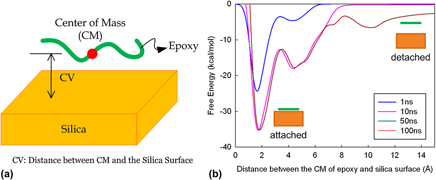Crossref Citations
This article has been cited by the following publications. This list is generated based on data provided by
Crossref.
Lau, Denvid
Büyüköztürk, Oral
and
Buehler, Markus J.
2012.
Multiscale modeling of organic-inorganic interface: From molecular dynamics simulation to finite element modeling.
MRS Proceedings,
Vol. 1466,
Issue. ,
Qin, Zhao
and
Buehler, Markus
2012.
Molecular mechanics of dihydroxyphenylalanine at a silica interface.
Applied Physics Letters,
Vol. 101,
Issue. 8,
p.
083702.
Gunes, Oguz
Lau, Denvid
Tuakta, Chakrapan
and
Büyüköztürk, Oral
2013.
Ductility of FRP–concrete systems: Investigations at different length scales.
Construction and Building Materials,
Vol. 49,
Issue. ,
p.
915.
Lau, Denvid
2013.
Moisture effects on nano-mechanical properties of epoxy-based materials.
p.
925.
Ghosh, Susanta
Kumar, Abhishek
Sundararaghavan, Veera
and
Waas, Anthony M.
2013.
Non-local modeling of epoxy using an atomistically-informed kernel.
International Journal of Solids and Structures,
Vol. 50,
Issue. 19,
p.
2837.
Naderi, Mahmood
and
Hajinasri, S. A.
2013.
Using Twist-off Method for Measuring CFRP/Concrete Adhesion when Exposed to Cyclic Temperature Changes, Wet-Dry and Freeze-Thaw.
The Journal of Adhesion,
Vol. 89,
Issue. 7,
p.
559.
Yang, Shaorui
and
Qu, Jianmin
2014.
An investigation of the tensile deformation and failure of an epoxy/Cu interface using coarse-grained molecular dynamics simulations.
p.
1.
Chen, Y.
Chia, J.Y.H.
Su, Z.C.
Tay, T.E.
and
Tan, V.B.C.
2014.
Molecular modeling of epoxide-amine systems: Topological cure conversion limit and its influence on material properties.
Polymer,
Vol. 55,
Issue. 23,
p.
6124.
Lau, Denvid
Broderick, Kurt
Buehler, Markus J.
and
Büyüköztürk, Oral
2014.
A robust nanoscale experimental quantification of fracture energy in a bilayer material system.
Proceedings of the National Academy of Sciences,
Vol. 111,
Issue. 33,
p.
11990.
Tam, Lik-ho
and
Lau, Denvid
2014.
Molecular Mechanics of Organic Composite Materials: A Case Study of Cellulose-Adhesive System.
MRS Proceedings,
Vol. 1662,
Issue. ,
Yang, Shaorui
and
Qu, Jianmin
2014.
An investigation of the tensile deformation and failure of an epoxy/Cu interface using coarse-grained molecular dynamics simulations.
Modelling and Simulation in Materials Science and Engineering,
Vol. 22,
Issue. 6,
p.
065011.
Sahoo, Hrushikesh
Rath, Swagat S.
and
Das, Bisweswar
2014.
Use of the ionic liquid-tricaprylmethyl ammonium salicylate (TOMAS) as a flotation collector of quartz.
Separation and Purification Technology,
Vol. 136,
Issue. ,
p.
66.
Yu, Zechuan
Xu, Zhiping
and
Lau, Denvid
2014.
Effect of Acidity on Chitin–Protein Interface: A Molecular Dynamics Study.
BioNanoScience,
Vol. 4,
Issue. 3,
p.
207.
Yu, Zechuan
and
Lau, Denvid
2015.
Molecular dynamics study on stiffness and ductility in chitin–protein composite.
Journal of Materials Science,
Vol. 50,
Issue. 21,
p.
7149.
Zhou, Ao
Tam, Lik-ho
Yu, Zechuan
and
Lau, Denvid
2015.
Effect of moisture on the mechanical properties of CFRP–wood composite: An experimental and atomistic investigation.
Composites Part B: Engineering,
Vol. 71,
Issue. ,
p.
63.
Tam, Lik-ho
and
Lau, Denvid
2015.
Moisture effect on the mechanical and interfacial properties of epoxy-bonded material system: An atomistic and experimental investigation.
Polymer,
Vol. 57,
Issue. ,
p.
132.
Tam, Lik-ho
and
Lau, Denvid
2016.
Micromechanics of Wood Cell Wall.
MRS Advances,
Vol. 1,
Issue. 58,
p.
3837.
Palkovic, Steven D.
Brommer, Dieter B.
Kupwade-Patil, Kunal
Masic, Admir
Buehler, Markus J.
and
Büyüköztürk, Oral
2016.
Roadmap across the mesoscale for durable and sustainable cement paste – A bioinspired approach.
Construction and Building Materials,
Vol. 115,
Issue. ,
p.
13.
Cui, Junhe
Yu, Zechuan
and
Lau, Denvid
2016.
Effect of Acetyl Group on Mechanical Properties of Chitin/Chitosan Nanocrystal: A Molecular Dynamics Study.
International Journal of Molecular Sciences,
Vol. 17,
Issue. 1,
p.
61.
Saha, Sourav Kr.
Murmu, Manilal
Murmu, Naresh Chandra
and
Banerjee, Priyabrata
2016.
Evaluating electronic structure of quinazolinone and pyrimidinone molecules for its corrosion inhibition effectiveness on target specific mild steel in the acidic medium: A combined DFT and MD simulation study.
Journal of Molecular Liquids,
Vol. 224,
Issue. ,
p.
629.
